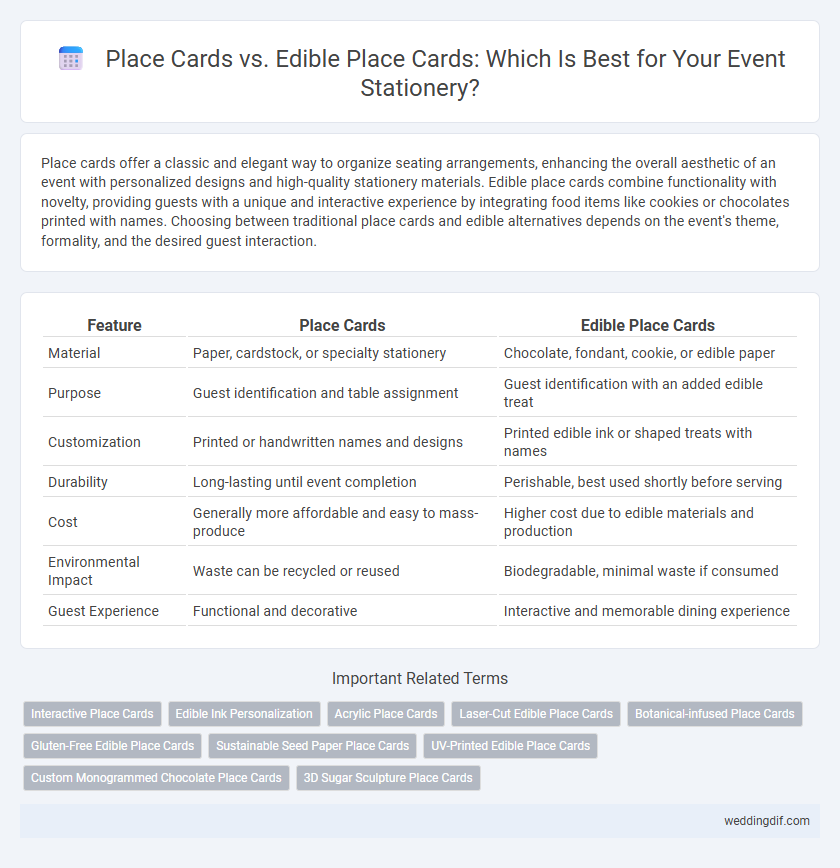Place cards offer a classic and elegant way to organize seating arrangements, enhancing the overall aesthetic of an event with personalized designs and high-quality stationery materials. Edible place cards combine functionality with novelty, providing guests with a unique and interactive experience by integrating food items like cookies or chocolates printed with names. Choosing between traditional place cards and edible alternatives depends on the event's theme, formality, and the desired guest interaction.
Table of Comparison
| Feature | Place Cards | Edible Place Cards |
|---|---|---|
| Material | Paper, cardstock, or specialty stationery | Chocolate, fondant, cookie, or edible paper |
| Purpose | Guest identification and table assignment | Guest identification with an added edible treat |
| Customization | Printed or handwritten names and designs | Printed edible ink or shaped treats with names |
| Durability | Long-lasting until event completion | Perishable, best used shortly before serving |
| Cost | Generally more affordable and easy to mass-produce | Higher cost due to edible materials and production |
| Environmental Impact | Waste can be recycled or reused | Biodegradable, minimal waste if consumed |
| Guest Experience | Functional and decorative | Interactive and memorable dining experience |
Introduction to Place Cards in Wedding Stationery
Place cards in wedding stationery serve as elegant markers that guide guests to their assigned seats while enhancing the overall table decor. Traditional place cards, typically made from high-quality paper or cardstock, offer a customizable surface for printed or handwritten guest names and can be designed to complement the wedding theme. Edible place cards, crafted from materials like sugar, chocolate, or fondant, combine functionality with a unique treat, merging seating assignments with personalized favors that delight guests and elevate the wedding experience.
What Are Traditional Place Cards?
Traditional place cards are small, decorative cards typically made from cardstock or high-quality paper, used to designate seating arrangements at formal events such as weddings, banquets, and corporate dinners. These stationery items are designed with elegant typography and often feature calligraphy or printed names to add a personalized, sophisticated touch to table settings. Unlike edible place cards, traditional place cards serve purely as visual identifiers and keepsakes without any consumable aspect.
Exploring Edible Place Cards: A Creative Alternative
Edible place cards offer a creative alternative to traditional stationery by combining functionality with a unique sensory experience, often crafted from materials like fondant, chocolate, or cookies that can be customized with names or designs. These consumable markers not only add a personalized touch to events but also reduce waste compared to paper counterparts, aligning with sustainable event planning trends. Incorporating edible place cards enhances guest interaction and leaves a memorable impression through both visual appeal and taste.
Design Options: Paper vs Edible Place Cards
Paper place cards offer extensive design options including various textures, colors, and custom prints, allowing for intricate patterns and personalized messages. Edible place cards, often crafted from fondant or chocolate, provide a unique, interactive design element but are limited in size and detail due to their edible nature. Both types can incorporate themes and branding, yet paper cards offer greater flexibility for complex visual effects and durability.
Customization and Personalization Opportunities
Place cards offer extensive customization through various materials, fonts, and designs, allowing for tailored themes and guest names that enhance event decor. Edible place cards provide a unique personalization opportunity by incorporating edible inks, customized flavors, and shapes that match the event's style, blending visual appeal with a memorable culinary experience. Both options elevate stationery by delivering distinct, personalized guest interactions, with customization ranging from intricate printing details to bespoke edible creations.
Guest Experience: Visual Appeal and Enjoyment
Place cards crafted from high-quality cardstock offer elegant visual appeal and a tangible keepsake for guests, enhancing table aesthetics with personalized designs. Edible place cards, made from fondant or chocolate, create a unique sensory experience by combining decoration with taste, delighting guests and adding a playful element to seating arrangements. Both options elevate guest experience by balancing sophisticated presentation and memorable enjoyment, tailored to event themes and ambiance.
Practical Considerations: Durability and Handling
Place cards made from sturdy cardstock offer superior durability and ease of handling, ensuring they remain intact throughout events and can be easily rearranged if needed. Edible place cards, while visually appealing and unique, are more fragile, prone to melting or smudging, and require careful handling to prevent damage before or during the event. For long-lasting use and efficient setup, traditional paper place cards provide greater reliability compared to edible alternatives.
Budget Comparison: Costs of Each Type
Place cards typically cost between $0.50 to $2 each, depending on materials and customization, making them a budget-friendly option for events with many guests. Edible place cards, often made from chocolate, cookies, or sugar sheets, can range from $3 to $7 per piece due to ingredient quality and detailed craftsmanship. Choosing between traditional and edible options depends on balancing desired presentation impact against overall event budget constraints.
Eco-Friendliness and Sustainability Factors
Place cards crafted from recycled paper or seed paper offer a sustainable stationery option that minimizes waste and supports eco-friendly practices. Edible place cards, made from natural ingredients like rice paper or chocolate, reduce landfill impact by being compostable or consumable, aligning with zero-waste event principles. Choosing biodegradable materials in place card production enhances overall environmental responsibility within event planning and stationery use.
Making the Right Choice for Your Wedding Style
Place cards offer timeless elegance and customization options with fine calligraphy and premium paper, complementing traditional and formal wedding themes. Edible place cards, such as decorated cookies or chocolate name tags, create a unique and interactive guest experience suited for casual or whimsical celebrations. Selecting between the two depends on your wedding's atmosphere, guest preferences, and desired visual impact on each table setting.
Place Cards vs Edible Place Cards for Stationery Infographic

 weddingdif.com
weddingdif.com